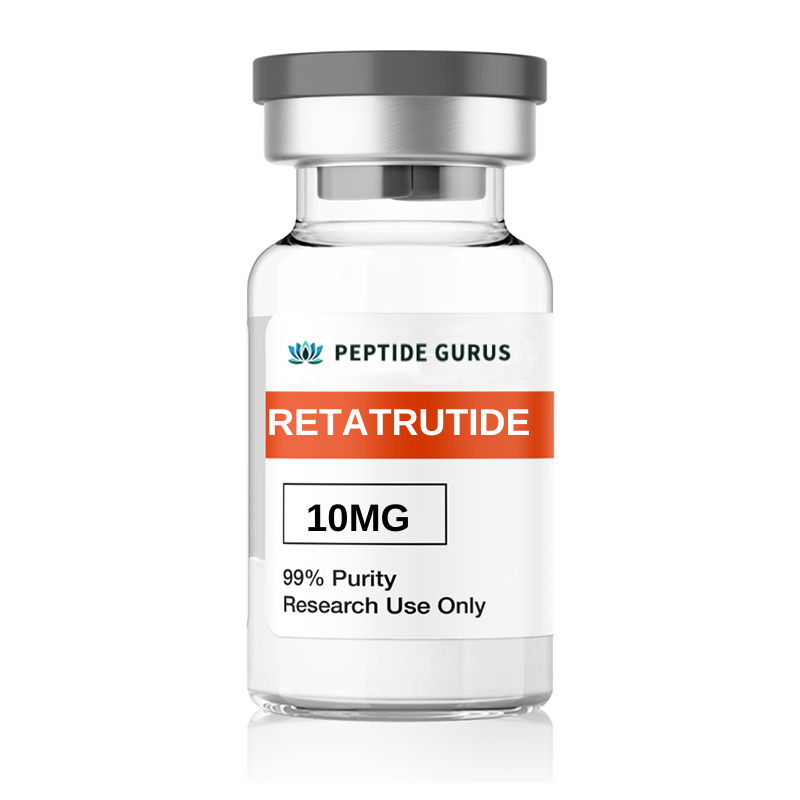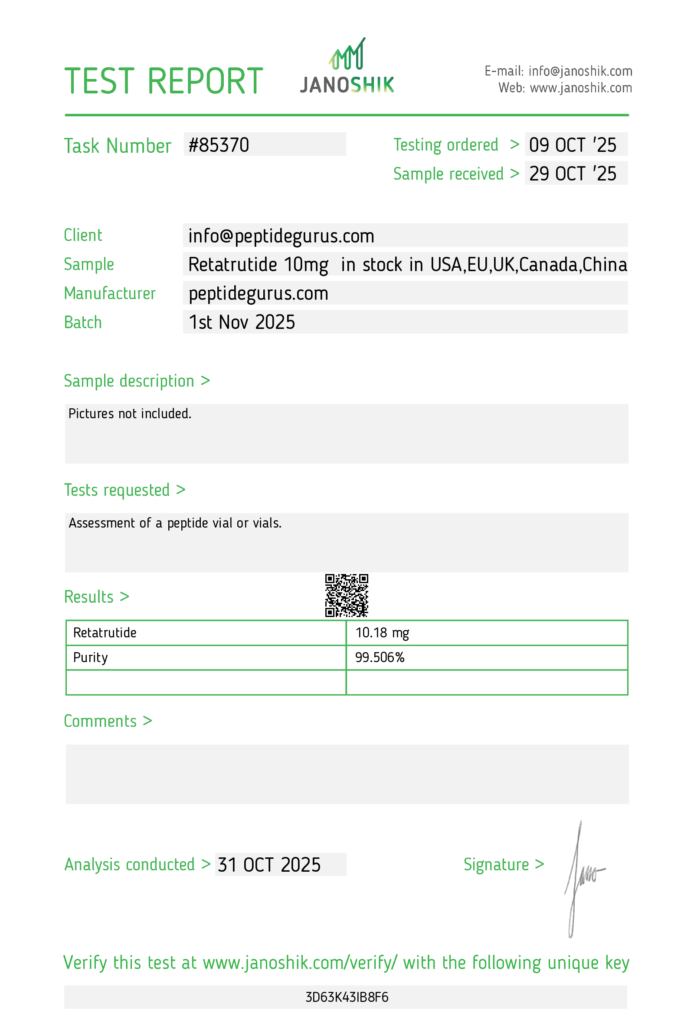




Categories: Hot Products, Peptide Finished product, Peptides and Their Dosages
Retatrutide (10 mg) is a next-generation multi-receptor metabolic research peptide that represents the forefront of peptide innovation for obesity and glucose-metabolism research.
Engineered as a triple agonist, Retatrutide simultaneously activates GLP-1, GIP, and glucagon receptors — three of the most important signaling pathways governing energy homeostasis, fat oxidation, and insulin regulation.
By combining the mechanisms of these three receptor families, Retatrutide enables researchers to study a holistic metabolic response that extends beyond single-target peptides. Early studies suggest this peptide’s triple-agonist design results in superior lipid mobilization, enhanced thermogenesis, reduced appetite signals, and improved glycemic control.
Each vial contains 10 mg of high-purity lyophilized Retatrutide, synthesized under controlled conditions and verified by third-party Janoshik laboratory analysis to ensure molecular accuracy and purity above 98%. This product is provided for research use only and is not approved for human or veterinary applications.
Retatrutide’s development marks a paradigm shift in the peptide-research landscape. While earlier incretin-mimetic peptides such as GLP-1 agonists (e.g., semaglutide) demonstrated notable improvements in appetite control and glycemic management, their effects plateaued due to receptor-specific limitations.
Retatrutide was designed to overcome this bottleneck by engaging:
GLP-1 receptors, promoting satiety and delayed gastric emptying.
GIP receptors, enhancing insulin sensitivity and anabolic metabolism.
Glucagon receptors, stimulating energy expenditure and fat oxidation.
This triple receptor synergy creates a more balanced anabolic-catabolic interplay, providing a comprehensive research model for studying systemic metabolic health, obesity reduction, mitochondrial efficiency, and hormonal cross-talk.
Researchers have reported Retatrutide’s potential relevance to:
Weight-management studies, modeling significant body-fat reduction.
Glucose homeostasis research, focusing on improved insulin signaling.
Lipid metabolism, investigating the acceleration of hepatic and peripheral fat oxidation.
Energy-balance and appetite regulation, via central and peripheral signaling pathways.
As such, Retatrutide is being recognized as a next-generation standard for exploring metabolic multi-agonists.
Triple receptor activation – GLP-1, GIP, and glucagon synergy.
Advanced weight-management model – simulates real-world metabolic responses.
High-purity peptide – >98% purity, Janoshik-certified.
Stable lyophilized format – optimized for long-term laboratory storage.
Ideal for metabolic, anti-obesity, and endocrinological studies.
Each vial of Retatrutide 10 mg is sealed under aseptic conditions using high-grade glass vials to preserve peptide stability.
Every production batch is accompanied by a Certificate of Analysis (COA) detailing HPLC and MS results confirming sequence integrity and purity.
All products are maintained in temperature-controlled storage facilities within our U.S.-based warehouse, allowing fast and compliant domestic shipping to qualified research institutions, laboratories, and distributors.
Store unopened vials at −20 °C in a dark, dry environment.
Once reconstituted, keep between 2–8 °C and use within a short research window.
Avoid repeated freeze-thaw cycles.
For laboratory research only; not for human or veterinary administration.
Retatrutide 10 mg is a high-purity triple-agonist research peptide targeting GLP-1, GIP, and glucagon receptors for metabolic, obesity, and glucose-control studies. Janoshik verified; ships from U.S. warehouse.
Retatrutide 10 mg, Retatrutide peptide, Retatrutide research peptide, GLP-1 GIP glucagon agonist, triple-agonist peptide, metabolic research peptide, weight-management peptide, obesity-research compound, peptide for glucose control, fat-oxidation peptide, energy-balance peptide, Janoshik-tested peptide, peptide for scientific research, Retatrutide USA stock
PeptideGurus is a leading supplier of American-made research peptides, offering top-quality products at competitive prices. With a focus on excellence and customer service, they ensure a secure and convenient ordering process with global shipping.
CONTACT